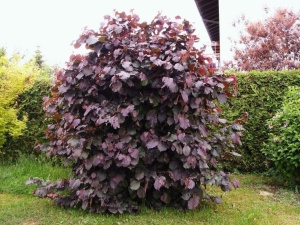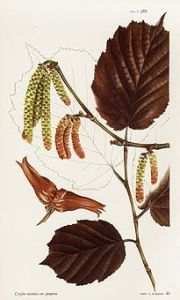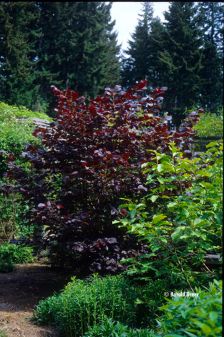Corylus maxima ‘Purpurea’
“Purple Hazelnut” “Filbert”
SAPINDACEAE
(was Betulaceae)
Deciduous Tree or Shrub
Zone: 4 – 9
Native habitat: Europe

Conditions
Soil: fertile
Moisture: well-drained, average moisture, can handle some drought once mature
Light: full sun
Exposure: shelter from harsh winds
Plant size (h x w): 15′ – 20′ x 15′ – 20′
Other:
 Aesthetic
Aesthetic
Shape/stem: upright, rounded, can be multi-stemmed
Leaf: handsome, 5.5″ wide, heart shaped, dark purple, heavily veined
Flower: monoecious; male: catkin, purple, showy; female: red insignificant
Bloom: February to March
Other: nut prupley brown; suckers
Treatment (how to…)
Plant: general
Maintain: can coppice to 2-3 buds every few years but generally minimal pruning needed; does sucker a bit, break off unwanted suckers from base about June 15th
Propagate: cutting, grafting
 Uses
Uses
Landscape: specimen tree, average garden tree, urban,
Companion planting: nice against bright greens (see left)
Medicinal: nuts are edible
Vulnerabilities
Pests and disease: none significant; may see caterpillars, saw flies, aphids
Deer resistant: no
Other animals: squirrels are attracted to and eat nuts
Interest
Local info,: not native
Pot size (to purchase): 1g or bigger (if not grafted are cheaper)
Nature: small ornamental tree
Identification (key features): broad, deep purple leaves heavily veined; late winter yellow catkins on leafless twigs hanging down followed by edible nuts concealed by a tubular husk
Interesting facts:
Cultivars:
